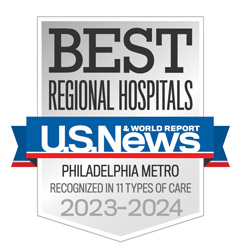 The aorta is the large blood vessel that carries oxygen-rich blood from the heart to the body’s vital organs. An abdominal aortic aneurysm (AAA) is a bulging or ballooning in a portion of the aorta that runs through the abdomen. This bulge can break open, causing life-threatening internal bleeding. An abdominal aortic aneurysm occurs when the abdominal aorta is dilated by 50%.
The aorta is the large blood vessel that carries oxygen-rich blood from the heart to the body’s vital organs. An abdominal aortic aneurysm (AAA) is a bulging or ballooning in a portion of the aorta that runs through the abdomen. This bulge can break open, causing life-threatening internal bleeding. An abdominal aortic aneurysm occurs when the abdominal aorta is dilated by 50%.
Surgeons in the Division of Vascular and Endovascular Surgery at Cooper University Health Care treat a high volume of patients with AAA. Research has shown that patients with AAA who receive care at high-volume centers have better outcomes than patients at low-volume facilities. Our specialists, who are solely dedicated to treating patients with vascular problems, ensure you receive compassionate and personalized care.
Why Choose Cooper for Abdominal Aortic Aneurysm Care?
Our internationally recognized vascular and endovascular surgeons have extensive experience diagnosing and treating AAA. They choose a treatment approach that is right for you, based on the size and location of the aneurysm and your overall health.
Some features of our program include:
- Expert diagnosis: Our vascular and endovascular specialists in the Aortic Center at Cooper use the latest imaging techniques to determine the size, shape, and exact location of your aneurysm. Tests may include:
- Abdominal ultrasound, which uses sound waves to create pictures of the aorta and the aneurysm
- Computed tomography (CT) scan, a combination of X-rays and computer technology that produces detailed pictures of the body, including the aorta
- Personalized approach to care: After diagnosis, we determine the best treatment options for your unique situation. If the aneurysm is small and isn’t causing symptoms, you may only need careful monitoring by our specialists. However, surgery is often the best approach for managing an AAA.
- A high-volume center: Our surgeons perform a large number of AAA repairs. This experience adds to their expertise and helps to ensure excellent outcomes. We offer the following procedures for treating AAA:
- Ascending aortic repair or replacement, a type of open surgery
- Endovascular abdominal aortic aneurysm repair, a minimally invasive endovascular procedure
Abdominal Aortic Aneurysm Risk Factors
While we don’t completely understand the causes of AAA, several risk factors are associated with the condition. These include:
- High blood pressure
- Atherosclerosis, hardening of the arteries
- Aortitis, inflammation of the aorta
- Diabetes
- Being age 65 or older
- Smoking
- Trauma to the abdominal aorta
- Family history of AAA
Abdominal Aortic Aneurysm Symptoms
Many patients who have an abdominal aortic aneurysm do not initially have symptoms. The growth of the aneurysm can be gradual and may not lead to symptoms until after it has grown for several years.
However, if the bulge grows rapidly and bursts, the most common symptom is a pulsating pain in the abdomen. The pain is often focused under your rib cage or in your stomach.

Other symptoms of abdominal aortic aneurysm may include:
- Severe and sudden pain or constant pain in the abdomen or back
- Pain in the back or abdomen that spreads toward the legs
- Dizziness or fainting
- Clammy skin
- Nausea or vomiting
- Rapid pulse
- Low blood pressure
- Shock
Blood clots can also develop, break off, and travel to other parts of the body, causing pain and other complications. A clot that travels to the brain may cause a stroke. Clots that travel to the heart may cause a heart attack.
Diagnosing Abdominal Aortic Aneurysm
A frustrating fact is that most people with an abdominal aortic aneurysm do not have any symptoms. An aneurysm is usually discovered by X-ray during an exam for an unrelated health issue.
If an abdominal aortic aneurysm is suspected, your doctor may use ultrasound or computed tomography (CT) scan to investigate it. If an AAA is confirmed, a vascular specialist will use several imaging tests to gather more information on the aneurysm’s size, shape, and exact location in the abdomen.
The Society for Vascular Surgery and the Society for Vascular Medicine and Biology recommends preventive screening abdominal ultrasounds for:
- Men aged 60 to 85
- Women aged 60 to 85 who have cardiovascular risk factors
- Men and women aged 50 and older who have a family history of abdominal aortic aneurysm
Treating Abdominal Aortic Aneurysm
The specialists in Cooper’s Vascular and Endovascular Surgery Program are at the forefront of treating AAA with an innovative procedure called endovascular abdominal aortic aneurysm (AAA) repair. Compared to an open surgery to repair an AAA, this minimally invasive procedure offers numerous benefits to patients, including:
- Shorter time for the procedure – the surgery takes 1 to 3 hours to complete
- Shorter hospital stay
- Smaller scars
- Faster return to normal activities after the surgery
Cooper’s vascular surgeons helped pioneer the development of an innovative procedure, which is becoming the preferred surgical approach to treating patients who have an AAA.
Contact Us
To learn more about services available in the Division of Vascular and Endovascular Surgery or to schedule an appointment, please call 856.342.2151.
Refer a Patient
If you are a doctor who wants to refer a patient to the Division of Vascular and Endovascular Surgery, please call 856.968.7067.
